It’s Sunday in New York and Central Park moves to Cuban rumba
The Cuban festival, which has been going on for over 60 years according to some estimates, begins when the heat of the summer months arrives in the Big Apple
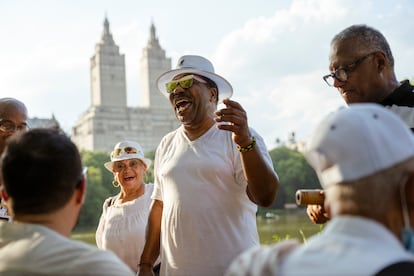

It’s Sunday in New York and Willian Hart is particularly annoyed. He’s arrived in Central Park, walked through Strawberry Fields and didn’t stop until he sat down on a bench facing the lake, close to the Bow Bridge. He pulled out his basket of rums and beers and set about selling his wares. “That one, the one you can see over there, is playing with my money, she’s taking what belongs to me,” he says, while pointing to a lady selling tamales, congri rice, tomato salad, old clothes, and beers.
That’s where his anger comes from: the beers. On Sundays there are certain unwritten rules, rules that neither the passing photographers, nor the enthusiasts, nor the dancers on duty are aware of, but that the Cubans, Puerto Ricans, and Dominicans who have been beating the secular drums of the Sunday rumba in Central Park for years, very much are. If Willian Hart sells beers, no one else can do so near his patch.
Hart arrived in the United States from Cuba in 1980, from Havana to New York, from Jesús María to the Bronx, aboard the ship Virginia. From the port of Mariel, 40 kilometers (25 miles) from the capital, Fidel Castro, in an act of political arrogance, let 125,000 Cubans, whom he later called “scum,” leave the country and travel to Key West. Hart is a marielito, like many of the rumberos of Central Park, or like Martha Castro, the 65-year-old lady who deploys her fan — as well as her waist — with vigor, and who waits furiously for the New York summer to attend the rumba.
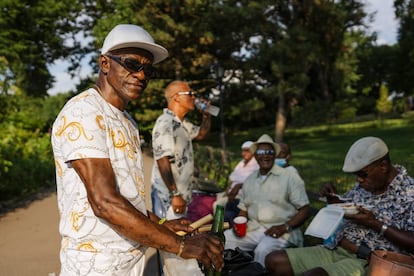
The rumba in Central Park, which has been going on for more than 60 years according to some estimates, does not have an exact start date, nor an exact end date. Its beginning is marked by the heat of the summer months, and its end by the onset of the low temperatures of winter. On this July Sunday the rumba, a party that usually starts around 4 p.m., is delayed: the musicians have not yet shown up.
The park, however, begins to fill up with people. Hart offers them beer while Wanda Santos, a Boricua he met five years ago in the same place, collects the money, which she then keeps in a small bag. They only accept cash; if you ask about the possibility of any other kind of transaction the answer is always the same: “Only cash, only money.” Hart and Santos have been a couple since he arrived at the rumba one day feeling down and she grabbed his arm and asked him to walk for a while. Hart grew up surrounded by rumba, in the courtyard of his house in the neighborhood of Jesús María, to which he will probably never be able to return.
— Never again?
— Esacly. I made many mistakes with the law. When you come from a country where they don’t give you access to anything, and you arrive in another country where you see the doors open, you go crazy, you get lost, and when you react it’s too late.
It’s a little after 5 p.m. and Bonifacio Pascual, or Boni, is ready for a dialogue. To dialogue is to sing in the language of rumba. Rumba is a permanent dialogue of the drum with the claves, of the claves with the tres-dos, of the tres-dos with the guagua (a hollowed piece of bamboo), of the guagua with the singer, of the singer with the chorus, and so on in all possible combinations. It is the rhythm and dance inherited from African ancestry, which came to fruition in the 19th century in Cuba and since then has been the Blackest expression of the Cuban neighborhood and now, beyond the island, a meeting place for exiles. In 2016, UNESCO declared Cuban rumba Intangible Cultural Heritage of Humanity.
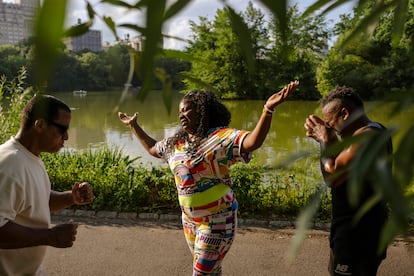
Rumba has changed, just as New York City has changed, just as its immigrants have changed. Today, it is different from the 1960s, when it was mostly performed by Puerto Rican musicians at the Bethesda fountain. The marielitos and later the so-called balseros, Cuban immigrants who crossed the Florida Straits in 1994, brought with them the most updated versions of guaguancó, columbia or yambú from the barrios of Havana or Matanzas, and the rumberos of New York joined in playing the newest rhythms from the island. But, however much it has changed, the essence of rumba is the same.
“Rumba is the lived experience. It is the last expression of humanity, and someday it will be demonstrated,” says Boni, who has arrived at the park fully dressed in white. When he was 20 years old, Boni left the port of Mariel on the vessel Rosemary. He remembers the day he arrived in the United States and how magnificent, how extraordinary, how amazing a supermarket looked to him. “I saw how people were buying things and my mind exploded,” he says. “I said, but in Cuba you have to wait in line to eat a loaf of bread, and look at these people here how they fill those carts. It didn’t seem possible.”
In a town in Pinar del Río, in the west of the island, he watched how his father made drums and then played them. He has never been back to Cuba but he always returns to Central Park. “It’s like going back to my country, this is like a delicious rumba in a backyard,” he says. When the other musicians are ready, Boni gives the order with his husky voice: “Pero dónde andaba Hilda, cuéntame tu vida,” he intones. The drums follow, the claves follow. The rumba breaks out.

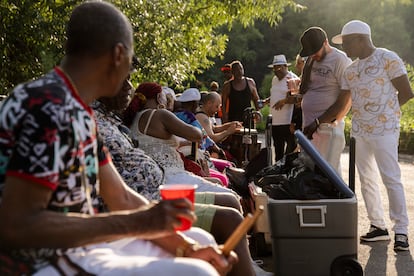

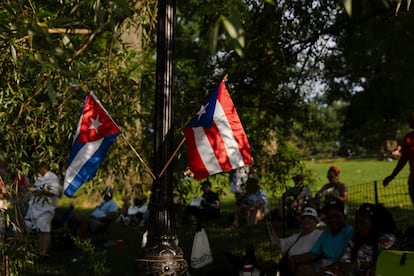

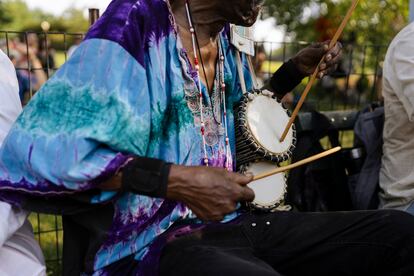
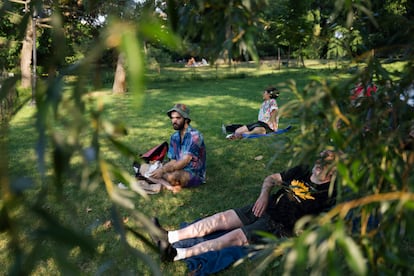

Also singing today is El Chino, a 72-year-old Venezuelan babalawo who sings like it’s always the last rumba. There’s Lisa Maya Knauer, a 67-year-old tenured professor at the University of Massachusetts, who contorts herself. She lifts her dress, shows her legs, twirls. It’s been 30 years this month since she started frequenting the Cuban rumba. “One day I was alone in the city, a friend had died, I was sad, and I said: where can I go now to find myself a little bit of a sense of community?” She has been coming ever since, and she dances without respite.
There is also Alfredito, “Pescao,” who had not attended for several Sundays, but today he does not cease singing. There is “Matanzas,” a rumbero who plays the cajón quinto. There is Leonardo Whitman, who arrived in the 1980s on the Maria Victoria, and who has no doubt that “to be a rumbero, you have to have an African heart inside.” He wears his white guayabera, linen pants, and two-tone shoes. He is completely convinced, with that patriotic and musical impulse, that the rhythms don’t sound the same when played by Dominicans or Boricuas as when played by Cubans. There are several young women who move their shoulders while not moving their feet, and move their feet when they slide their hips. There are several families having a picnic, some boats and lovers crossing the Bow Bridge, and in the background, the picture where the two baroque towers of the San Remo building rise, like a sacred stamp of the city.
Also in attendance is Rafael Corn, a French Broadway musician, who one day thought he was a rumbero but in reality was not. “I saw this and thought, well, conga, I studied conga, I’ve taken lessons, I can play,” he says. Corn had studied percussion outside Paris. Many years ago, living in New York, he felt the rumba in Central Park and wanted to play. He brought his drums, he was ready, but he was not allowed to join the sacred group of the park’s rumberos. “I thought that, if they were my drums, they had to let me play, but they wouldn’t let me,” he said.
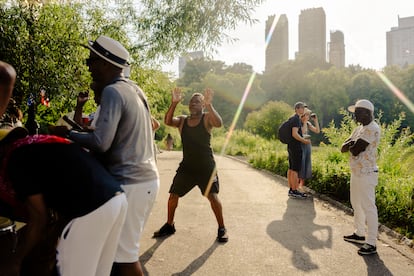
Corn left almost in tears. He was 18 years old. Then he went to Cuba and learned that rumba was something else. “It’s a whole different atmosphere,” he says. Whenever he can, Corn gets to Central Park on Sundays. He’s one of them and knows, he’s convinced, that you don’t have to be Cuban to leave your soul in a drumbeat. “There are Cubans who suck at drumming,” he notes.
Dusk is falling in Central Park. The heat is relentless, sweat covers several faces. The tamale lady shouts that she has two tamales left. A girl asks, please, for a cigarette. The avalanche of people that was spinning around the drums says goodbye, disperses, disappears with the night. Someone begins to sing “Rosa, how beautiful you are,” and a diminished chorus replies: “Rosa, how beautiful you are.”
Sign up for our weekly newsletter to get more English-language news coverage from EL PAÍS USA Edition
Tu suscripción se está usando en otro dispositivo
¿Quieres añadir otro usuario a tu suscripción?
Si continúas leyendo en este dispositivo, no se podrá leer en el otro.
FlechaTu suscripción se está usando en otro dispositivo y solo puedes acceder a EL PAÍS desde un dispositivo a la vez.
Si quieres compartir tu cuenta, cambia tu suscripción a la modalidad Premium, así podrás añadir otro usuario. Cada uno accederá con su propia cuenta de email, lo que os permitirá personalizar vuestra experiencia en EL PAÍS.
¿Tienes una suscripción de empresa? Accede aquí para contratar más cuentas.
En el caso de no saber quién está usando tu cuenta, te recomendamos cambiar tu contraseña aquí.
Si decides continuar compartiendo tu cuenta, este mensaje se mostrará en tu dispositivo y en el de la otra persona que está usando tu cuenta de forma indefinida, afectando a tu experiencia de lectura. Puedes consultar aquí los términos y condiciones de la suscripción digital.
More information
Archived In
Últimas noticias
Tiger Woods turns 50: Will he continue playing on the PGA Tour or take a back seat?
The surreal journey of James Nnaji, the Barcelona youth player selected in the NBA Draft who ended up in the NCAA
Trump claims peace in Ukraine is near, but Moscow suggests otherwise
A survivor’s account of the Interoceanic Train accident: ‘We were scared because of the speed on the curve’
Most viewed
- Oona Chaplin: ‘I told James Cameron that I was living in a treehouse and starting a permaculture project with a friend’
- Reinhard Genzel, Nobel laureate in physics: ‘One-minute videos will never give you the truth’
- Sinaloa Cartel war is taking its toll on Los Chapitos
- Why the price of coffee has skyrocketed: from Brazilian plantations to specialty coffee houses
- Chevy Chase, the beloved comedian who was a monster off camera: ‘Not everyone hated him, just the people who’ve worked with him’










































